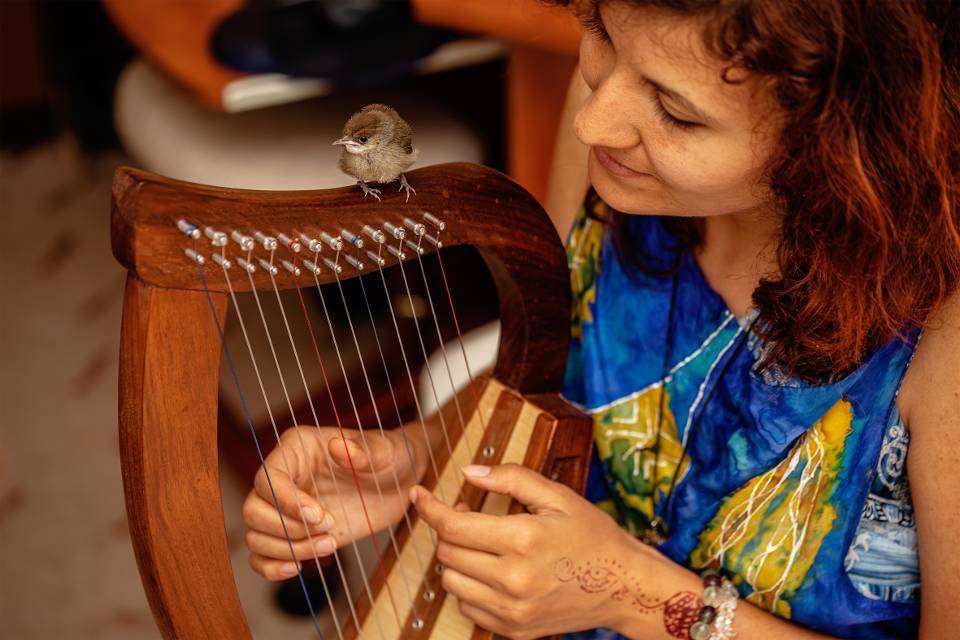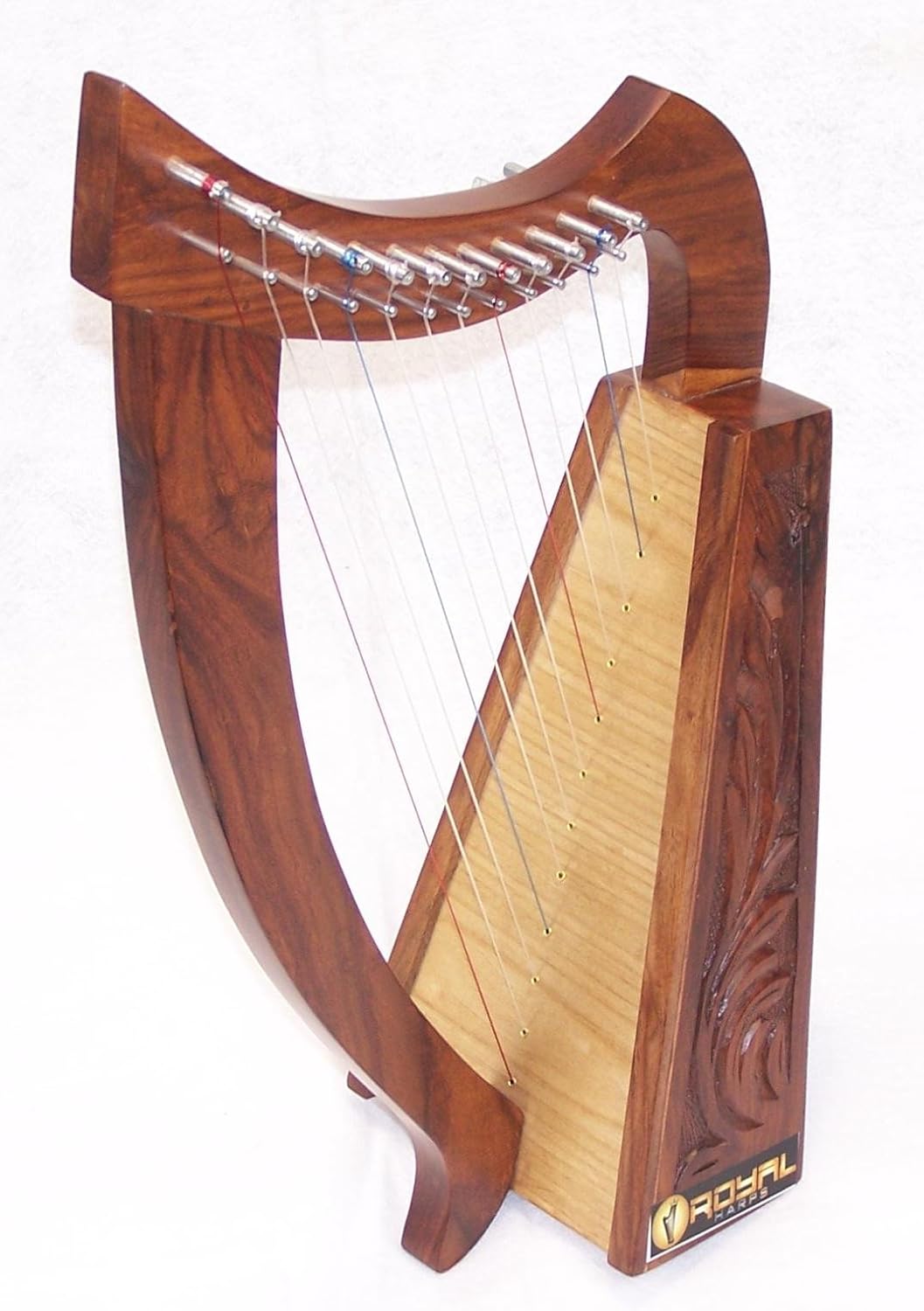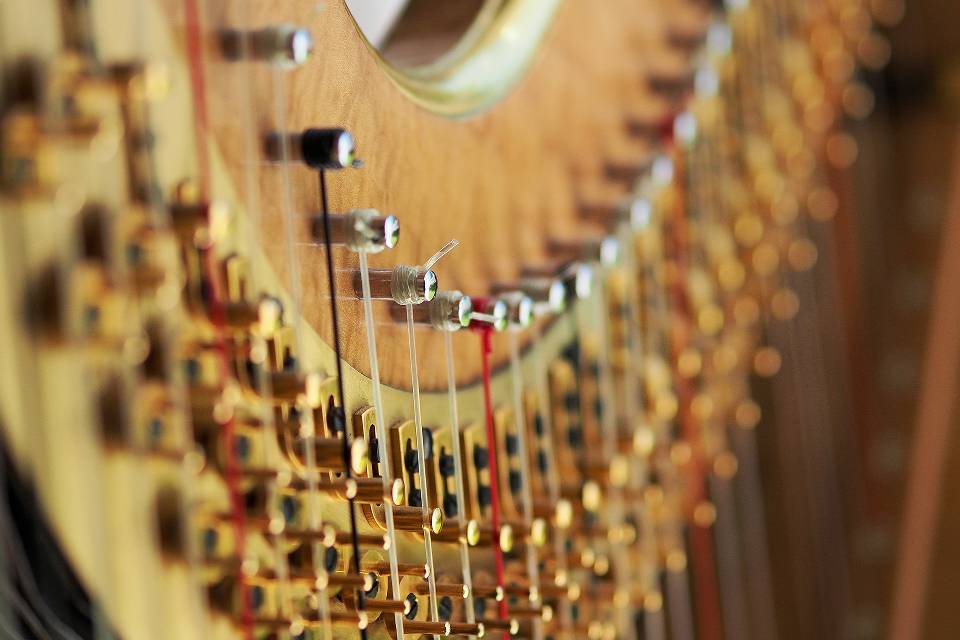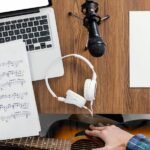
From so many instruments that we have to choose from today, the harp has to be one of the most underrated choices out there. This very versatile and expressive instrument dates way back to the old ages, and it got its modern design defined in Europe during the Renaissance era. Its appealing tone and very exciting nature made it so widespread, and it eventually found its way into classical music and even some “unconventional” musical movements, like the world music.
Of course, different versions can also be found in traditional folk music. We can also stumble upon an occasional experimental use in rock, heavy metal, and other modern music genres, although this is pretty rare.
If we’d define it in a simple way, we could say that the harp is a stringed instrument with each note having its individual string standing at an angle. These strings are fingerpicked with both left and right hands.
Contents
- 1 Different Types of Harps
- 2 How Does a Harp Work
- 3 How Much Does a Harp Cost
- 4 Harps for Beginners Review
- 4.1 Best for Young Beginners: Royal 12-String Children’s Harp
- 4.2 Best Deal for the Price: Roosebeck 12-String Baby Harp
- 4.3 Best for Intermediate Players: Harpsicle Fullsicle Harp
- 4.4 Best Celtic Harp: Royal Celtic Irish Knee Harp
- 4.5 Best Overall: Harpsicle Harps Rees Special Edition Fullsicle Harp
- 4.6 Best Lute Harp: Roosebeck Lute Harp
- 4.7 Best Design: Balladeer Harp TM
- 5 Frequently asked questions
- 6 Conclusion
Different Types of Harps
After the instrument’s evolution over the years, we now have a few different types of harps. However, there are also many other types of harps, including Celtic, multi-chorus, and chromatic harps.
Concert Harps or Pedal Harps
The most famous one is the concert harp or the so-called pedal harp. In their essence, pedal harps are diatonic instruments, meaning that the strings are tuned to one particular scale. But by using pedals, you can alter the pitch of the strings and either play in a different key, or just add chromatic alterations.
Multi-Chorus
Multi-chorus harps have multiple rows of strings, as opposed to other types of harps that have only one row of strings. These are also referred to as “double-harps” since they have two rows of strings.
Celtic and Folk Harps
Celtic harps, or folk harps usually have nylon strings and have levers that can help you alter the pitch of the strings. These are relatively smaller and they don’t have any pedals. They’re diatonic, meaning that they’re in one key.
Of course, there are also other types of harps or harp-like instruments. Going through history, lyres and instruments like medieval harps also fall into this same category. They’re usually not so widespread and are mostly used in folk music.
Chromatic
Chromatic harps are pretty interesting. Instead of being in one key (diatonic), these harps cover all of the 12 semitones in one octave. They can either have strings in one line, or are cross-strung, just like multi-chorus harps. Although not as widespread, these are used by some experienced harp players and are in some ways very practical since there’s no pedals or levers involved.
Electric harps
Although not as common, there are some electric harps that convert string vibration into an electrical signal, just like electric or electro-acoustic guitars. These can also come as hollow-body or solid-body instruments. For picking up the string vibration, these harps use piezo pickups for each individual string. Some of the electric harps also combine this signal with the one from internal microphones.
How Does a Harp Work
Although it would take a lot of time to fully explain how harps work, some basic concepts are easy to figure out. Harp is a stringed instrument where the strings are plucked using your fingers. The sting then vibrates, the body resonates, and you get a sound. The strings differ by thickness and length, with the length being determined by the instrument’s construction. These two factors determine the pitch of each string.
Harps usually have a so-called “soundbox” with its sound holes. When a string vibrates, this part amplifies the sound, making it loud enough for everyone to hear.
Pedal harps have pedals that alter the pitch of strings. By pressing them, you get outside of the diatonic bounds of the harp’s tuning and get more notes. Beginners can do well with some simpler harps without any pedals and other complicated controls.
How Much Does a Harp Cost
Harp is a delicate and specific instrument, so the price can vary. Simple beginner harps can be anywhere from a couple of hundred dollars and up to $1,000 or $2,000. However, regular harps can get pretty expensive. Folk harps can be anywhere between $1,000 and $5,000, while pedal harps can get well-over $10,000. Fully professional concert harps can be astronomically expensive, surpassing $100,000 or more. With more complex construction and with better materials, harp prices increase drastically.
See more: Harp Price Range and Factors Impact to Harp Price
Harps for Beginners Review
Best for Young Beginners: Royal 12-String Children’s Harp

If we’re talking about the youngest students, finding the best harp for beginners might not be that easy. You need a small, light, and easy-to-play instrument, that will also not be that expensive. At the same time, it needs to have some of the basic quality concepts that will teach the youngest students about the most important aspects of this fine instrument. But while all this sounds like an impossible task, this is exactly what you’ll get with Royal’s 12-string Children’s Harp.
With this particular harp, we have a very simplified body that makes it easier for anyone to play it. However, it still keeps its resonance with a very clever soundbox design. Of course, it’s not possible to make a fully functioning harp at this size and price point, but it still manages to deliver great performance. And what most important, it has all the necessary elements that can teach a beginner about all the basic concepts. If we’re talking about the youngest beginners, this will be the perfect instrument for them since its size ad overall features are accommodated for them.
The youngest players might get attracted to harps since these are pretty exciting instruments. However, the parents might be discouraged with the prices and the overall complex nature of this instrument. Luckily, a harp-like this Royal’s 12-string is accommodated for even the youngest music lovers. Not to mention that the price is pretty reasonable as well. So wouldn’t it be a shape if they’d not get the chance to play one?
Pros
- Affordable
- Great deal for the price
- The best option if you’re looking for a beginner harp for the youngest players
Cons
- It has only 12 strings
Best Deal for the Price: Roosebeck 12-String Baby Harp

Roosebeck also have some very interesting instruments in their arsenal to offer. Talking about harps, and beginner harps in particular, they also have a good 12-string deal with their 12-string Baby Harp. In many ways, it’s similar to the one that we detailed above. We have the same type of configuration and construction. However, we’d argue that here we have a better choice of materials and overall better performance.
In fact, this harp is not only for the youngest students. And despite its pretty low price (which is not much higher than the one for Royal’s 12-string harp), you can get a pretty great performance. Of course, this is far from an intermediate or professional level instrument, but it’s still pretty amazing how it sounds for this price category.
Although very simple in its construction, the soundbox resonates pretty well and even manages to get some subtle dynamical nuances of one’s playing. Yeah, we once again have only 12 strings here, but it’s pretty much enough for an absolute beginner. Whether you’re looking for something that will fit young players or those mature ones who are just looking for a simple harp to start on, you can’t really go wrong with this one.
In addition, this harp comes with a couple of goodies. You also get a spare set of strings, as well as a tuning tool. This way, with proper instruction, you’ll also be able to learn how to restring a harp. Of course, this is an important aspect if you’re looking to cover all the aspects of harp playing.
Pros
- Cheap
- Really great deal for its price
- Quality build
- Quality materials
- Sounds decent
Cons
- Only 12 strings
Best for Intermediate Players: Harpsicle Fullsicle Harp

Needless to say, many music enthusiasts are really keen on learning to become professional players one day, or at least semi-pros. Of course, this requires an appropriate instrument, no matter what their choice is. This can, however, get a little complicated with harps, as the choice is not really easy to make. No matter the age, you’ll need something that will serve you well even when you reach an intermediate level. If you’re really serious about your future musicianship and music career as a harp player, then we’d recommend this great Fullsicle Harp, which is made by a company called Harpsile.
Here we have a harp with 26 strings. It’s about 36 inches tall, although it’s relatively light for its size, about 6.5 pounds. But what’s really exciting is that this harp comes with levers for its strings. This means that it’s not just a simple diatonic harp that can be played in just one key. With all of its settings, you can set it to be in either of these eight keys: E, Eb, Bb, F, C, G, D, and A. It might be a bit of an advanced concept for beginners, but it’s necessary if they want to become good at playing a harp.
However, there are a few more things that you need to bear in mind. These harps take a bit more time to be made, usually about 6 to 8 weeks. This also means that Fullsicle Harps are not exactly the cheapest ones out there. But despite their higher prices, they’re most certainly worth it. So far, almost all of the buyers have been extremely satisfied, and there aren’t really that many things to complain about. What’s more, it’s usually possible to order it in different color finishes, so that’s interesting as well.
Pros
- Has 26 strings
- Using its levers, it can be set to 8 different keys
- It’s pretty light for its size
- Comfortable to play
Cons
- It might be a bit expensive for beginners
Best Celtic Harp: Royal Celtic Irish Knee Harp

Just like we already explained in the intro of this guide, there are also Celtic harps, which are focused on Celtic or generally any folk music where the harp is a welcome instrument. And it’s not really uncommon for beginners to be into this kind of music in the first place. So all those who are interested in Celtic harps, there’s one great piece by Royal Harps, that will come in handy for you.
This Celtic harp is about 27 inches tall and comes with a total of 17 strings. What’s really surprising for this price level is the fact that its body is made from solid wood, it has hand-engraved styles, and it’s been hand-polished.
Overall, this harp is pretty compact and it’s intended for kids. However, the overall tone quality makes it stand out, and you’ll be able to play it even in some more advanced stages of your music journey. It’s a very simple instrument without any additions to it. But at the same time, it really fits any setting where a Celtic harp would be appropriate.
What’s really practical is that it also comes with a bag and an additional set of spare strings. Alone, these two items would be an additional significant investment, so this makes it a pretty great deal. If you need a nice beginner folk harp, you just need to check this one out.
Pros
- Easy and comfortable to play
- Affordable price
- Great for Celtic and generally any folk music
Cons
- Not very versatile
Best Overall: Harpsicle Harps Rees Special Edition Fullsicle Harp

Like we already mentioned, there are beginner musicians who are aiming for the best. This, however, comes with its price. On the other hand, the price is worth it if you get a good instrument. Although a bit complex and relatively expensive, this one by Harpsicle Harps is something you’ll really have to check out if you’re serious about becoming a good harp player.
This one is 33 inches tall and has 26 strings in total. It comes with special Rees Levers that are pretty well-made. Just like the other model by Harpsicle Harps that we mentioned, this one is also pretty light. At the same time, it provides you with a wide range and gives a lot of versatility for different musical styles. It’s a bit of an advanced piece, but beginners who are really keen on learning the instrument will find it to be really useful.
Pros
- Really great quality
- Good tone
- Very ergonomic and comfortable to play
Cons
- It’s a bit expensive for some beginners
Best Lute Harp: Roosebeck Lute Harp

For the next instrument, we’re looking into a company called Mid-East. However, this one is not like the other harps that we mentioned here, although it’s a great choice for beginners due to its size and overall accessibility. Lute harps, or harp lutes as some may call them, combine the concept of the famous medieval and renaissance instrument with the harp.
As far as this instrument made by Roosebeck goes, it features 22 nylon strings and is about 27 inches tall. It’s a simple diatonic instrument and it covers three octaves, going from C4 to C7. Since it’s so simple and compact, it’s a great option for beginners of many different age groups. There aren’t any levers and other similar components, so it’s pretty easy to figure out and play.
Pros
- Easy to play
- Great choice for beginners
- Sounds good
Cons
- Not as versatile as some other harps
Best Design: Balladeer Harp TM

Lastly, we would like to take a closer look at this simple little beginner harp, which is another one by Mid-East company. The instrument model in question is called Balladeer Harp TM, and it’s a pretty beginner-friendly harp. This one is about 30 inches tall, has 22 string, as well as 22 levers. Although it might be a bit advanced for some beginner tastes, it’s a pretty great compact choice for anyone who intends to learn all the advanced concepts of this fine instrument. This great and compact harp also comes with an additional set of strings and a tuning tool, which makes it a pretty great deal for the price. And as if this wasn’t enough, you also get an amazing beginner’s book with all the basic concepts.
But although these are all amazing features, we couldn’t help but single out its design as its overall best quality. In fact, you won’t ever be able to find such a great-looking harp within this price level. If aesthetics are an important factor in buying an instrument, then this is the one to look into.
But even putting the overall looks aside, the instrument sounds pretty great. For this price, you’ll get a sound box that resonates pretty well and gives enough sustain for any particular setting that you need.
Pros
- Compact and easy to play
- Has an amazing design
- It’s pretty cheap
Cons
- It might be a bit too advanced for some beginners
Frequently asked questions
How Many Strings Does a Harp Have?
When buying the best harp for beginners that will suit your needs, one of the first things to consider is the number of strings. However, beginner harps come with way fewer strings compared to professional ones. Standard full-sized pedal harps that professional concert performers play have 47 strings. Although this is a standard, you’ll also find some great professional-level harps with 46 or even 48 strings, with some occasional examples going as low as 40. With 47 strings, you get six and a half octaves.
But if we’re looking into beginner harps, you have anything from 12 strings and up. As you can see from this guide, there are harps with 22 strings or 26 strings as well. It’s a pretty unusual instrument either way, so any number is possible from 12 to 30 within the beginner range. And, of course, there are even those super-small harps with only 8 strings, but these aren’t as common as other options.
What are Harp Strings Made of?
As you can already see by now, harps are versatile instruments, and the overall features depend on many different factors. As far as string materials go, it can get a bit versatile well. In the case of those standard classical harps, nylon is a usual material, just like you can find with classical or flamenco guitars. This can also be heard in their tone.
In many cases, you can also find steel strings. Once again drawing a parallel with guitars, these are steel cores with a soft copper wire wrapped around them. But there are, of course, some other variants as well, like phosphor and bronze combo used for the core, with either a copper wire wrapped around it or (interestingly enough) a thin soft nylon string.
Nylon strings have that softer tone with a very specific attack and an overall mellow vibe. Steel strings will resonate in a different way and will usually give a significantly brighter sound. Nylon strings are typical of classical music, while steel strings are intended for many different genres, as is the case with guitar strings. Of course, you’re always free to experiment and do whatever fits your artistic views.
How Much Does a Harp Weight?
Once again, we need to differentiate between professional harps and beginner harps. If we’re talking about those big classical concert harps, these usually go way past the 30 kg mark, with 36 kg, or about 80 pounds, being the “standard” weight in this level.
But when it comes to beginner harps, the weight gets significantly lower. Like we already explained, there are some harps that are about 6 or 6.5 pounds. In the absolute beginner level, it goes even lower than that, with children’s harps going as low as 3 pounds.
As you can see, this is a pretty versatile factor, and it usually depends on the playing level you’re aiming for. But the more the strings you have and the more features it includes, the heavier this instrument gets.
Conclusion
As you can see from this guide, the harp is a pretty delicate and complex instrument. Of course, it’s far from an impossible task to figure it out and become good at it. However, the harp is usually a pretty expensive instrument, and you’ll need to be ready to give a substantial sum if you’re planning on becoming an advanced harp player.
But as far as beginner harps go, it’s easy to find some simple stuff that’s pretty affordable. In fact, the harps that we detailed above aren’t any expensive than some great beginner or intermediate-level guitars, keyboards, trumpets, or any other instruments. At the same time, you need to remember that the cheaper the instrument, the less versatile it gets.
If you’re looking for the best harp for beginners, it might get a bit tricky at some point, but any of the instruments that we mentioned above are worth it and work pretty great for this level. It’s just up to you to decide what will fit your needs the most and how it will impact your overall advancement as a musician. If you’re an absolute beginner, lower price and practicality are your main concerns.






